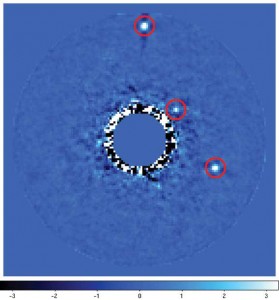TORONTO [15 December 2016] In November 2016, a powerful new instrument designed to search for distant, Jupiter-like worlds, reached its critical “first-light” milestone. After years of development and testing, the Coronagraphic High Angular Resolution Imaging Spectrograph, or CHARIS, was declared operational and ready to gather data on the Subaru Telescope in Hawaii.

A CHARIS image taken during testing shows the previously identified exoplanetary system around the star HD 8799. The planets are indicated by the red circles; the star is hidden in the centre of the image. Image: CHARIS/Princeton Team and NAOJ
CHARIS is the latest of a new breed of astronomical instruments designed to find planets beyond our Solar System—known as exoplanets—by imaging them directly. While the Kepler Space Telescope has found over two thousand exoplanets indirectly by measuring minute changes in the brightness of stars, CHARIS and other recently developed instruments like it allow astronomers to actually see distant worlds.
“CHARIS has exceeded our expectations, which led to overwhelming demand for observing time even before we’d finished evaluating the instrument,” says CHARIS-team member, Jeff Chilcote, a Dunlap Fellow at the Dunlap Institute for Astronomy & Astrophysics, University of Toronto.
“With CHARIS, we now have a planet-imaging instrument in the northern hemisphere giving access to a whole new set of stars that complements the sky that the Gemini Planet Imager (GPI) can see from Chile.”
A typical star is a million times brighter than a planet in orbit around it, so an exoplanet imaging instrument must integrate a powerful combination of technologies in order to find its quarry. First, the adaptive optics (AO) systems of the Subaru Telescope and CHARIS combine to greatly reduce the blurring caused by the Earth’s turbulent atmosphere. Then, a component called a coronograph blocks the light of the star, revealing the much fainter point of light that is the exoplanet.
But CHARIS is more than an imaging instrument. It is also a spectrograph; it splits the light from its target according to wavelength. The resulting spectrum reveals a wealth of information about the exoplanet, including information about its motions, temperature and chemical composition.
CHARIS was developed by an international team that includes Chilcote, and is led by Principal Investigators N. Jeremy Kasdin from Princeton University, and Masahiko Hayashi from the National Astronomical Observatory of Japan.
Chilcote was also a member of the team that developed the Gemini Planet Imager instrument. GPI is on the Gemini South Telescope in northern Chile and spied its first exoplanet in August, 2015.
The CHARIS team will begin their search for distant worlds in February 2017.
Additional notes:
The CHARIS project included, in addition to Kasdin, Hayashi and Chilcote, a large team of researchers. The CHARIS instrument was designed and built at Princeton under the direction of Tyler Groff, who now works for NASA’s Goddard Space Flight Center. Other team members included: Michael Galvin, Michael Carr, Craig Loomis, Norman Jarosik, Johnny Greco, Robert Lupton, Edwin Turner, James Gunn and Gillian Knapp of Princeton; Mary Anne Limbach of Limbach Optics; Nemanja Johanovic, of the Subaru Telescope; and Timothy Brandt of the Institute for Advanced Study.
-30-
Dr. Jeffrey Chilcote
Dunlap Fellow
Dunlap Institute for Astronomy & Astrophysics
University of Toronto
p: 416-946-5432
e: chilcote@dunlap.utoronto.ca
For more on the Dunlap Institute:
Chris Sasaki
Communications Co-ordinator
Dunlap Institute for Astronomy & Astrophysics
University of Toronto
p: 416-978-6613
e: csasaki@dunlap.utoronto.ca
The Dunlap Institute for Astronomy & Astrophysics at the University of Toronto is an endowed research institute with over 40 faculty, postdocs, students and staff, dedicated to innovative technology, groundbreaking research, world-class training, and public engagement. The research themes of its faculty and Dunlap Fellows span the Universe and include: optical, infrared and radio instrumentation; Dark Energy; large-scale structure; the Cosmic Microwave Background; the interstellar medium; galaxy evolution; cosmic magnetism; and time-domain science.
The Dunlap Institute, Department of Astronomy & Astrophysics, Canadian Institute for Theoretical Astrophysics, and Centre for Planetary Sciences comprise the leading centre for astronomical research in Canada, at the leading research university in the country, the University of Toronto.
The Dunlap Institute is committed to making its science, training and public outreach activities productive and enjoyable for everyone, regardless of gender, sexual orientation, disability, physical appearance, body size, race, nationality or religion.
###
